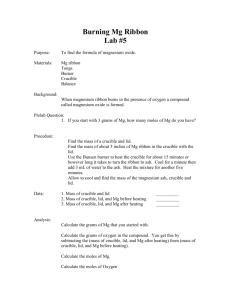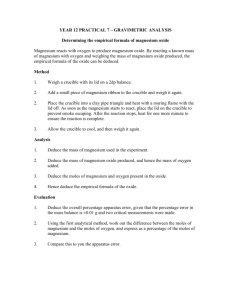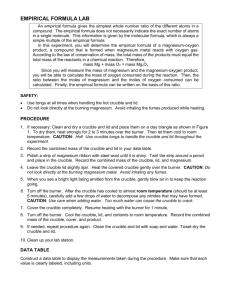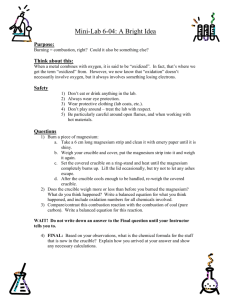Empirical Formula of Magnesium Oxide Lab Worksheet
advertisement
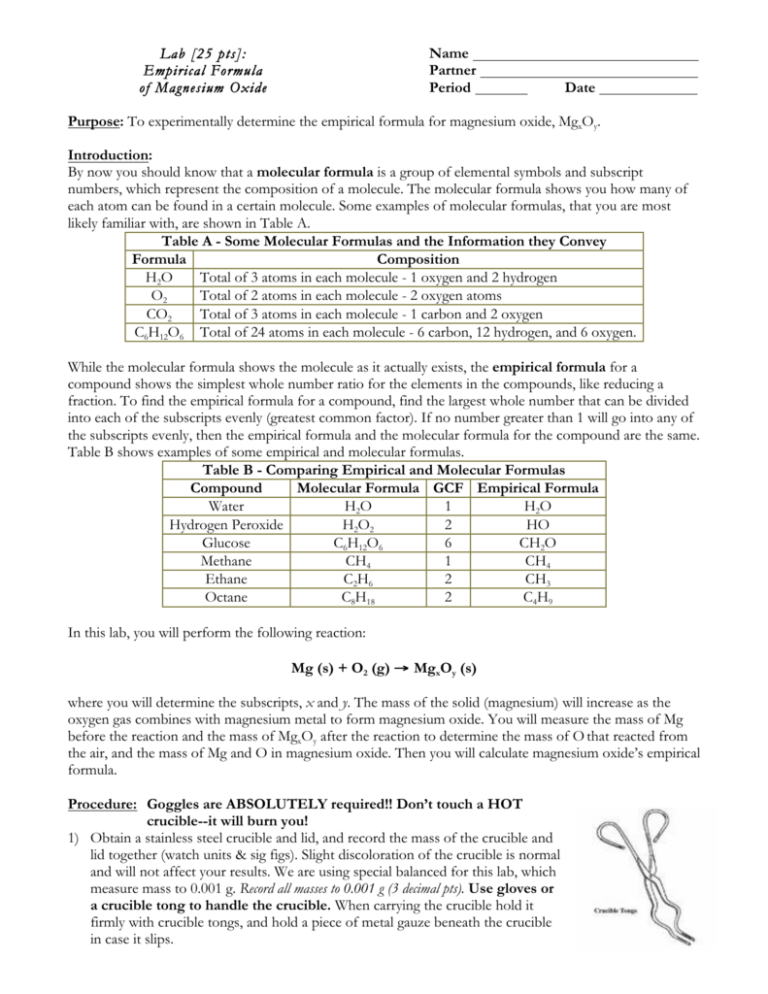
Lab [25 pts]: Empirical Formula of Magnesium Oxide Name Partner Period Date Purpose: To experimentally determine the empirical formula for magnesium oxide, MgxOy. Introduction: By now you should know that a molecular formula is a group of elemental symbols and subscript numbers, which represent the composition of a molecule. The molecular formula shows you how many of each atom can be found in a certain molecule. Some examples of molecular formulas, that you are most likely familiar with, are shown in Table A. Table A - Some Molecular Formulas and the Information they Convey Formula Composition H2 O Total of 3 atoms in each molecule - 1 oxygen and 2 hydrogen O2 Total of 2 atoms in each molecule - 2 oxygen atoms CO2 Total of 3 atoms in each molecule - 1 carbon and 2 oxygen C6H12O6 Total of 24 atoms in each molecule - 6 carbon, 12 hydrogen, and 6 oxygen. While the molecular formula shows the molecule as it actually exists, the empirical formula for a compound shows the simplest whole number ratio for the elements in the compounds, like reducing a fraction. To find the empirical formula for a compound, find the largest whole number that can be divided into each of the subscripts evenly (greatest common factor). If no number greater than 1 will go into any of the subscripts evenly, then the empirical formula and the molecular formula for the compound are the same. Table B shows examples of some empirical and molecular formulas. Table B - Comparing Empirical and Molecular Formulas Compound Molecular Formula GCF Empirical Formula Water H2 O 1 H2 O Hydrogen Peroxide H2 O2 2 HO Glucose C6H12O6 6 CH2O Methane CH4 1 CH4 Ethane C2 H6 2 CH3 Octane C8H18 2 C4 H9 In this lab, you will perform the following reaction: Mg (s) + O2 (g) → MgxOy (s) where you will determine the subscripts, x and y. The mass of the solid (magnesium) will increase as the oxygen gas combines with magnesium metal to form magnesium oxide. You will measure the mass of Mg before the reaction and the mass of MgxOy after the reaction to determine the mass of O that reacted from the air, and the mass of Mg and O in magnesium oxide. Then you will calculate magnesium oxide’s empirical formula. Procedure: Goggles are ABSOLUTELY required!! Don’t touch a HOT crucible--it will burn you! 1) Obtain a stainless steel crucible and lid, and record the mass of the crucible and lid together (watch units & sig figs). Slight discoloration of the crucible is normal and will not affect your results. We are using special balanced for this lab, which measure mass to 0.001 g. Record all masses to 0.001 g (3 decimal pts). Use gloves or a crucible tong to handle the crucible. When carrying the crucible hold it firmly with crucible tongs, and hold a piece of metal gauze beneath the crucible in case it slips. 2) Obtain a strip of magnesium metal 12 – 13 cm long. 3) Loosely roll the magnesium metal into a loose coil and place it into the crucible. Record the mass of the crucible, lid and magnesium. Determine the mass of magnesium. WATCH SIG FIGS! 4) Place the crucible with Mg ribbon and lid on a clay triangle (see diagram at right). Put the crucible cover on with a slight crescent opening. Heat strongly with a Bunsen burner. Record your qualitative observations below for steps 4-5, 7-8, and 9-10. 5) Allow the Mg to completely react. Periodically check the magnesium by opening the lid, which also allows oxygen in, but DO NOT let the smoke out. Stop heating when the magnesium no longer smokes or glows when you open the lid. When done, use tongs to put the lid and crucible on the lab bench. Put the lid upside-down so no product transfers to the bench. 6) Allow the crucible to cool until you can feel no heat with your finger about 1 cm away from the crucible. 7) Carefully poke the contents with the tip of a clean glass stirring rod. If the solid crumbles completely, move on to step 8, otherwise continue heating the crucible & contents for another 3-5 minutes. Record observations! 8) Slowly add 15 drops of deionized water to the crucible (use this to rinse the residue from the stirring rod back into the crucible). Note in qualitative observations whether or not you smell ammonia (waft!). 9) Put crucible, contents, & lid back on the stand. Heat the crucible slightly more gently than before for 3-5 minutes to dry the product. Open the lid: does the product look dry? Record! 10) Cool the crucible and lid on the gauze until cool enough to comfortably touch. Be careful to put the lid upside-down so no product transfers to the gauze. Record the mass of the crucible, lid and product. Calculate the mass of magnesium oxide product. 11) CLEAN UP: When done lab, carefully wash out your crucible and lid with water. Use a brush to remove any powder. Rinse with deionized water. Return wet crucibles & lids to oven. Put away the ring stand, clay triangle etc. (Careful, wait until they cool down!) Data Table: (5 pts) Mass of crucible, lid & magnesium metal = Mass of crucible & lid = Mass of magnesium metal = Mass of crucible, lid & magnesium oxide product = Mass of crucible & lid (from above) = Mass of magnesium oxide product = Qualitative Observations: (5 pts) Step 4-5: Step 7-8: Step 9-10: Empirical Formula of MgxOy 2 Calculations (5 pts) Show all work. All numbers must have units. All numbers must have the correct sig figs! 1) [1 pt] Determine the mass of oxygen that must have combined with the magnesium: 2) Based on your data, determine the following results. Make sure you show your mole ratio with correct # of sig figs in part (c) before you round to integers in part (d). (a) [1 pt] Determine the number of moles of Mg in your product. (b) [1 pt] Determine the number of moles of O in your product. (c) [1 pt] Divide the larger moles by the smaller moles to determine the decimal mole ratio of Mg to O or O to Mg to the correct number of sig figs. (d) [1 pt] Determine the empirical formula (integers!) for MgxOy (show how you rounded your answer from part c). Post Lab questions (10 pts): Answer the following questions in the space given below. 1) [2 pts] The molecular formulas of some substances are as follows. Write their empirical formulas. a) Acetylene, C2H2 (used in oxyacetylene torches) b) Lactose, C12H22O11 (milk sugar) c) Decane, C10H22 (a component of gasoline) d) Ammonium nitrate, NH4NO3 (a component of fertilizer) Empirical Formula of MgxOy 3 2) [2 pts] A sample of silver nitrate contains 18.0 g of Ag, 2.3 g of N and 8.0 g of O. What is its empirical formula? 3) [2 pts] A sample of sodium carbonate is made up of 43.4 % Na, 11.3 % C and 45.3 % O. What is its empirical formula? (The easiest way to do this problem would be to assume that you have a 100 g sample. Thus, how many grams of each element would you have?). 4) [2 pts] The actual empirical formula of magnesium oxide is MgO — a 1:1 mole ratio. What was your mole ratio (in calculation 2c)? Was your mole ratio too high in magnesium (Mg > O) or too high in oxygen (O > Mg)? 5) [2 pts] Regardless of your results, discuss one possible systematic (procedural) error that could cause your product to apparently have too much magnesium and one possible systematic error for appearing to have too much oxygen. NOTE: Any errors are most likely caused by an incorrect mass of the product since you directly measured the mass of the magnesium. Thus, a ratio too high in magnesium is the same as having too little oxygen in product or too little product. Too high in oxygen could be because product is too heavy . However, you cannot get too much oxygen by burning the Mg longer—the reaction stops when the correct amount of O has reacted! Empirical Formula of MgxOy 4




